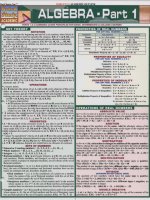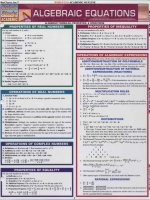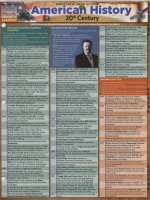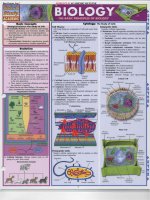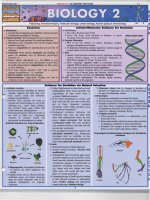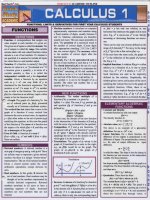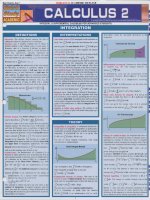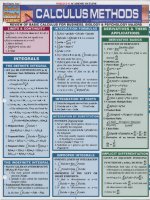Quick study academic comparative religions 600dpi
Bạn đang xem bản rút gọn của tài liệu. Xem và tải ngay bản đầy đủ của tài liệu tại đây (15.81 MB, 6 trang )
EVOLUTION OF RELIGION
A. ORIGINS
I. The oldest religious symbol found to date is the
sculpted torso of a female, the Earth Mother, found
in an ancient grave.
2. The oldest evidence for the belief in some form of af
terlife are Neanderthal burial sites - some 60-70,000
years old. In these graves, the corpse was buried with
various implements and supplies carefully arranged
around it - presumably to prepare it for the afterlife.
B. DYNAMISM
I. The belief that there are forces in nature that
humans can use to their benefit.
2. Mana is a force that can be harnessed and magic is
the knowledge that is required in order to use mana.
Typically, sympathetic magic is used- rituals that
imitate what is sought; e.g., the rain dance, fertility
rituals, voodoo, etc.
C. ANIMISM: The Soul or Spirit Worship
I. Beliefs about some form of spiritual afterlife arising
from the fear of death.
2. Dreams are often thought to be the means for the
spirit to contact the afterlife or spirit world.
3. Most animism takes the form of ancestor worship.
a. Some spirits are worshiped as spirits of the
dead; furthermore. anything alive may have a
spiritual presencc.
b. Spirits may be believed to guard houses or property.
4. Some related words:
a. Rite: A specific group of prayers and rituals
performed in sequence to achieve a desired effect.
b. Shaman: Specialists in these rituals, with knowledge
of the spirit world; also called Seers, or Witches.
c. Cult: A specific set of rites to a specific god.
d. Taboo: A limited, or forbidden, thing or action.
D. THERIOMORPHISM
i . Gods are pictured as various animals, seen especially
in Native American culture. A hierarchy of spirits
exists and may be very difficult to deal with.
2. Totemism: The belief that a divine animal created
humans and gave them everything they know.
E. ANTHROPOMORPHISM
I. God or gods take on the form or characteristic of
humans.
2. May relate to physical, moral or emotional qualities.
F. POLYTHEISM
1. A system of having many gods; gods may be viewed
as growing old and dying.
2. Stages A-D (above) may historically be co-occurring
with stage F.
3. Within a polytheistic culture, the lower classes
typically create more and more gods, while the
upper classes create fewer and fewer gods; this
process occurs simultaneously for the two classes.
G. MONOTHEISM
I. The worship of one and only one God, generally
regarded as immortal, omniscient, omnipotent,
omnibcncvolent, personal and immutable.
2. All the major Western religions (Judaism,
Christianity and Islam) are monotheistic and non
Pantheistic (God is viewed as supernatural and
separate from the world).
3. Some related words:
a. Revelation: A message God has given humans in
order to reveal himself. Typically, revelations
communicate God's plans for a people, God's
commandments for proper behavior and, possibly,
prophecies of God's future plans or actions.
b. Prophet: A divinely inspired messenger of God.
The criteria and qualifications for being a genuine
prophet often cause controversy within a religion;
similarly, an alleged prophet may face violent
opposition from established religious leaders when
he or she challcnges the religious stutus quo.
Hindu
] Buddhist, Taoist (intermixed)
Tribal
Undocumented
CHRISTIANITY
A. CENTRAL DOCTRINE
I. A monotheistic religion contending the most
complete revelation of God was personified in Jesus
of Nazareth.
2. Jesus is conceived of as hoth human and divine.
a. As divine, he is the incarnation of God: He is the
Christ - God in human form.
b. As human, he is the man Jesus of Nazareth, but
unlike any other humans, without sin.
c. The most crucial beliefs in this religion:
i. Jesus Christ was resurrected from the dead on
~
Easter Sunday.
ii. God is believed to be
manifest in three personas:
Father, Son and Holy
Spirit. This doctrine of
the Trinity is rejected by
Jews and Muslims.
JESUS CHRIST
B. CHRIST
I. Jesus is viewed as having been born of the Virgin
Mary and living a morally exemplary life. He
demonstrated his teachings by example, parable,
sermons and miracles.
2. It is claimed as the Son of God, Jesus made a
willing sacrifice - through his crucifixion - so that
through his blood, those who believe in him would
be cleansed of sin. Many Christians view this
sacrifice as an act of grace - a great gift bestowed
upon an undeserving humanity.
C. THE SACRED AND THE PROFANE
I. Christian thought is characterized bv a certain
duality that divides reality into the profane (to
include nature and the human body) and the sacred
(to include God, spirit and soul).
2. Historically, Christianity has demonstrated a certain
antagonism toward the natural world as profane, and
therefore inferior, matter. This tendency has at often
times surfaced in historical Christianity as a negative
attitude toward physical pleasure and the human body.
D. HUMAN NATURE
1. Humans are viewed as created in "the image of
God" and, unlike other creatures, have responsi
bility to God and are morally accountable.
2. Regarding human nature, there is some division in
Christian views:
a. Some contend that humans are inherently sinful
from the time of birth and can only overcome this
sin with God's help.
b. Another view holds that humans are capable of
acting in keeping with God's wishes aJl(~ through
proper nurture and devotion to God, can live
morally acceptable lives.
c. Both views, however, agree that God's grace is
essential.
E. SALVATION
1. Only through the grace of
God is salvation possible.
2. Christianity contends that
only by accepting Jesus Christ
as one '5 savior can onc be
saved through gracc.
3. Good deeds in themselves arc
insufficient to guarantee
salvation; rather, good deeds
may be evidence of repentance WESTMINSTER ABBEY
after a person is already saved.
LONDON
4. A person who is saved will live a morally exemplary
life due to love of God and his/her fellow humans.
5. In sum, worshippers arc saved by grace through faith.
F. THEODICY
I. An attempt to explain
how
a
merciful ,
benevolent God can
allow evil to exist
especially
the
seemingly undeserved NOTRE DAME CATHEDRAL
suffering of innocents.
PARIS
2. There arc sevcral possible answers to this probleIll:
a. Some contend that the suffering of innocents Illay
help save others. This is most clearly shown in the
example of Jesus' sulTcring on the cross for the
salvation of humanity.
b. St. Augustine held that human suffering is for the
sin of Adam.
c. Lastly, it has been contended that the suffering of
Christian martyrs gave a powerful demon
stration of the value of Christian faith.
d. Ultimately, it can be held that the existence of
evil is an unfathomable mystery to humans and
only to be understood by God.
G, FAITH AND REASON
I. Historically, the Church has held that unaided human
reason can lead to truth as well as scripture.
2. Nonetheless, faith and scripture arc thought to be
more reliable compasses to truth, since reason is
subject to human error.
3. An extreme position in this regard is fideism: The \ iew
that on!}' thmughjaith can truth and God be known.
CHRISTIANITY
(CONTINUED)
H. FAITH AND SCIENCE
I. Traditionally, there has been some tension between
the Church and science as to how to resolve the
seeming discrepancy between Biblical and scien
tific views of the natural world.
2. The Catholic Church has attempted to resolve the
discrepancy by contending that Biblical truths are tmths
offaith and scientific truths are tmths ofreason; the two
opemte on pamllel planes and are, thus, not in conflict.
3 Current divisions fall into roughly two categories:
a. Liberal: This view claims the Bible is only
metaphorical or allegorical when it comes to the
natural world.
b. Fundamentalist: Claim that the Bible is to be under
stood as literally true; hence, in those cases when
scientific discoveries are at odds with Scripture, the
scientific outlook is discounted.
c. Authority: The Bible was the sole
source of authority to be under
stood by each Christian according
to his/her own conscience.
BIBLE
d. Infallibility of the Pope: The
infallibility of the pope on matters of morals and
religion was denied.
e. Celibacy of Priesthood: Priests were free to marry
according to the dictates of their own conscience.
f. Sacraments: Luther recognized only two sacra
ments based upon scripture: Baptism and the
Lord's
Supper
(Communion).
Roman
Catholicism has retained seven: Baptism,
Eucharist, Confirmation, Marriage, Holy Orders,
Penance and Anointing the Sick.
L. CALVINISM
I. Calvinism 's
main doctrines were
systematically revealed in John
Calvin's Institutes of the Christian
I. ROMAN CATHOLICISM
Religion (1559).
As the self-proclaimed old
2. Calvinism differed from the
est embodiment of Chris- "1P"J:_.·t::.c~
Lutheran Protestant views more
tianity, the Holy Roman
in degree than kind, perhaps the
Catholic Church adheres to L.."".......T~../
most notable difference being the
several principle doctrines:
belief in the predestination ofsouls.
I. Biblical Interpretation:
3. Calvinism has traditionally been
The Bible is to be inter- 1:.l..;';';;_ _iiiii_iiliiiil.::Oi&~
a more austere religion, taking a
CALVIN
preted by Bishops and Papal
THE :~:~CAN
guarded view toward the consumption of alcohol
directive. Specifically, the
and other pleasures, such as dancing.
Pope's authority is held to be infallible in matters
M. AFTER-EFFECTS OF THE REFORMATION
conceming religion or morals.
2. Apostolic Succession: The pope and bishops are in a
linear spiritual succession to Christ and as such, their
authority carries, in varying degrees, the same spiritual
legitimacy that Christ conferred upon his apostles.
3. Dogma: Certain doctrines are unquestioningly
accepted such as the Gospel of Christ, the wine drunk
and wafer eaten during communion as the literal (and
not just symbolic) blood and body of Christ, and the
beliet: in the Immaculate Conception.
4. Confession: The church implements a mechanism
for the atonement of sin through confession.
5. Saints: Certain individuals who have demonstrated
particularly exemplary moral qualities and can be
verified as having been party to, or performed at
least one miracle, may be "canonized" - i.e. , recog
nized as saints.
6. Grace: The belief that though no ordinary human,
no matter how pious, ever deserves or merits
salvation, God freely bestows this gift upon the
undeserving due to his love and goodness.
7. Sacrament: An observable sign of something
sacred or a visible sign of divine grace; specifically,
seven sacraments are upheld: Eucharist, Baptism,
Confirmation, Penance, Anointing of the Sick,
Matrimony and Holy Orders.
J. THE EASTERN ORTHODOX CHURCH
I. Developed in the Greek
tradition, separate from the
Latin, or Roman Catholic,
Church.
2. Besides factors of politics
and geography, the two
churches split due to GREEK ORTHODOX
doctrinal differences over
CHURCH
icons, the infallibility of the
GREECE
pope and the marriage of priests.
1. The most noticeable effect of the Protestant
Reformation upon Christianity has been the
fragmentation of mainstream Protestantism into a
myriad of denominations, each differing on the
particulars of how scripture is to be understood.
2. Given Luther 's initial emphasis upon the personal
relationship between God and the individual , this
development is understandable.
3. The diversity of the forms of
Protestant Christianity runs the
spectrum from denominations such as
the Episcopalian Anglican Church,
which is quite similar to the Roman
Catholic Church, to more novel devel
opments, such as Christian Science,
Church of Jesus Christ of Latter-Day
Saints (Mormons), Unitarianism,
Unificationism and others.
TEMPLE
CALIFORNIA
N. POSSIBLE FUTURE TRENDS
I. With the evolution of new technologies and social
political struggles , Christianity faces many
challenges in the new millennium.
2. Moral problems posed by such developments as
cloning and genetic engineering are likely to raise
new challenges to the church.
3. Liberation Theologv. with its emphasis on social
injustice, is likely to remain a growing intluence in
developing countries and possibly produce new
emerging doctrines relating to the proper relation of
Christians to their community.
4. Other issues confronting Christians in the new
millennium may well include the ordination of
female priests, same-sex marriages, increased
secularization and relations to other religions.
K. THE REFORMATION
I. Initiated in the sixteenth century by Martin
Luther, the Protestant reformation divided
Christendom on several key issues.
2. Luther took exception to several doctrines of the
Roman Catholic Church, most notably:
a. The Bible: Luther claimed that a
Christian was free to have a . . . . . .~
personal relationship with God
and the intervention of priests
to read and interpret the Bible
was not necessary.
b. Latin: The Bible could be trans
lated into other languages and
Latin need not be the sole
LUTHER
language of scripture.
JUDAISM
A. CENTRAL DOCTRINE
1. Judaism encompasses some four millennia of devel
opment; as such, it is a dynamic historical record of
the experience of worship of a people who identify
themselves as children (descendants) of Abraham
(circa: 2,000 B.C.).
2. The basic tenet of this religion is that God made a
covenant with a group of people chosen to demon
strate God 's requirements to the rest of humanity; as
such, it could be argued that a Jew is accountable to
a higher moral standard than a non-Jew due to this
higher responsibility to God.
3. In contrast to Christians who accept C hrist as the
Messiah, Jews, by not accepting Christ as divine,
are still waiting for their Messiah.
B. THE CHOSEN PEOPLE
I. Jews think of themselves as being chosen as the
people responsible to God.
2. It is traditionally accepted that this group studies
and follows God 's commandments, thus making a
covenant with God.
C. THE TORAH
I. The Jewish Bible is actually a set of books; the
most important of these is the Torah.
2. The first five books of the Old Testament
comprise the Jewish Torah.
3. Although Moses is credited with the
origin of the Torah , the language (i.e. ,
the vocabulary and style) of the JiJrah
seems to date from around 800 B.C.,
whereas Moses lived around 1,200 s.C.
4. The Torah may be understood in
conservative or liberal interpretations:
a. Conservative: The Bible is the actual
word of God and is, thus, without
error. It is an accurate account of the
history of the Jewish people.
b. Liberal: The Bible is the product of
the interaction of God with his
chosen people and a record of their understanding
of God's revelation.
5. Historically, a conservative interpretation has prevailed
with the liberal interpretation becoming _ _ _~
more prevalent in modern times.
D. MOSES
I. Moses lived around 1,200 s.C. and
introduced the commandments that
are part of the Torah.
2. Moses is the most important person in
Jewish history, as he is credited with
bringing the children of Israel out of
bondage in Egypt (circa: 1,300 B.C.)
and the covenant between God and his
people was renewed under Moses.
3. By accepting God 's commandments (as delivered
by Moses) , the Hebrews agreed to serve God exclu
sively; in return, God would bring them to tJ,
Promised Land and make them a great nation.
E. THE NATURE OF GOD
I. The traditional characteristics of monotheism
reside in the God of the Tomh: God is endowed
with omniscience, omnipotence and omnibcnevolence.
2. Perhaps most importantly, God makes a covenant
with the chosen to protect, instruct and show them
compassion; in return, the people uphold God ',;
laws, worship and show proper devotion.
3. God is traditionally conceived of as a personal God
- a God with whom a personal onc-to-on e
relationship is possible.
4. In some interpretations however. God is a flllldamental ,
unfathomable mystery.ooG(xl oo is a verb. not a noun: a
process, not a singularity; ultimately indescribable and
incomprehensible to the human mind.
5. This veneration of God by some Jews is carried on
to the extent they will dedim; to write the word
" God oo and refrain from any naming of "it:'
F. THE HOLOCAlJST
I. The systematic genocide of millions ofJcw,; by the
Nazis (circa. 1933- 1945) is the single most signit~
icant pivotal event in recent Jewish history.
2. Theologically, it presents a challenge to explain
how an omnibencvolcnt God could have allowed
such a calamity to occur.
3. Politically, it was to underscore the need fix a Jewish
homeland and provide an impetus fl)r Z ionism.
G. NATURE AND THE WORLD
I. Unlike C hristianity, Judaism displays no animosity
to the natural world. Though God is supernatural
(i.e., separate from nature), the world is nevertheless
God's creation. Part of the covenant with God is the
responsible stewardship over this creation.
2. It could bc argucd that desecrating narure dishonors
God and breaks the covenant and trust' placed in the
chosen people.
3. The historically negative anitud.; toward the
body and nature as " profane ." f,mnd in
C hristianity. is not present in Judaism.
H. IMMORTALITY
I. Judaism places less emphasis upon an afterlif~ than
does C hristianity.
2. Although resurrection from the dead is a part of
Jewish doctrine, Judaism has focused upon a good
life on earth and fellowship with God during the
person's lifetime.
Ii
I
I
:
I
I
I. DISTINGUISHING BETWEEN JUDAISM AND
CHRISTIANITY
I. Although Judaism recognizes people of other
religions can serve God and live according to God's
laws, there are significant exceptions.
2. Judaism is a monotheistic religion that condemns
all forms of idolatry and rejects polytheism.
,. Trinitarian Christianity is rejected as polythe
istic and Christianity in general is rejected, since
Judaism does not accept Jesus as the Messiah.
4. Lastly, Judaism considers calling Jesus "God"
blasphemous.
J. FORMS OF JUDAISM
I. Reform
a. Emphasizes the ethical tradition of the Torah;
the Torah's teachings are pertinent only for the
ethical lessons they teach; regulations concerning
kosher foods, ceremonial purity and dress are no
longer thought relevant.
b. Reform Judaism allows the sexes to sit together
during services and the ordination offemale rabbis.
Services are customarily conducted in English.
2. Conservative
a. Requires strict observance of the Torah and Talmud.
b. Services are generally conducted in Hebrew,
adherence to kosher dietary ~
laws is encouraged and
males wear head coverings
in the Synagogue.
i
c. Zionism (the establishment
.
of a Jewish homeland) is an
TALMUD
important concern.
d. Allows for the ordination of qualified women as
rabbis.
3. Reconstructionism
a. Attempts to reformulate Judaism in a modem,
scientifically-oriented perspective.
b. Denies that Jews are a "chosen people" and is,
thus, often at odds with more Orthodox Judaism.
c. Designed to appeal primarily to educated,
intellectual Jews.
i. The supernatural aspects of Judaism are rejected.
ii. Focus is upon living in accordance with the
ethical requirements of Judaism.
4. Orthodox
a. Retains as many of the old traditions of the
Torah and Talmud as possible.
i. During services, the sexes are segregated; men
wear head coverings and prayer shawls.
ii. The service is in Hebrew.
iii. Members adhere to kosher dietary laws.
b. Orthodox rabbis generally do not recognize
Reform and Conservative forms of Judaism and
do not accept rabbis of these denominations as
equals in religious authority.
c. Although assimilated in the modern world,
Orthodox Jews are expected to uphold their
Jewish faith without compromise.
5. Hassidism
a. Members of this tradition consider themselves
the "'pious ones" and are dedicated to the Torah
and leading pure lives.
b. Although involved in modern society, members
of this group seek to maintain Judaism in the
most ancient form possible.
c. Rcgulations regarding proper diet, dress, ritual
and study are strictly obscrvcd.
Ir
1\,
K. THE QUESTION OF JEWISH IDENTITY
I. Within the Jewish community, there has been some
controversy concerning exactly what makes an
individual authentically Jewish.
2. Historically, most agree that Jews were initially
distinguished as a group by their acceptance of
the blessings and responsibilities of God's
covenant.
3. Today, Orthodox rabbis have difficulty accepting
members of non-Orthodox denominations as
legitimate Jews. The question of whether a
convert to one of these non-Orthodox denomina
tions is entitled to Israeli citizenship poses a
problem for many Orthodox.
4. Beyond this, other issues include whether Judaism
is a religion, an ethnicity, a culture or a heritage.
=~
ISLAM
A. CENTRAL DOCTRINE
I. Strict monotheism; there is but one God, Allah
(trans. "the God").
2. Muhammad is God's messenger - a prophet.
3. Although Moses and Jesus are also recognized as
prophets, Muhammad's message is thought to be
God's final revelation.
4. The divinity of Jesus is explicitly rejected by Mus
lims, as is the Trinity.
5. Islam allows for belief in angels (for example, the an
gel Gabriel is thought to have brought Muhammad
his first revelation) and the personification of evil.
B.MUHAMMAD
I. Born in 570, Muhammad received his first
revelation from God in 610.
2. In the ensuing 20 years, he received many revela
tions from God; the compilation of these revela
tions comprise the Quran.
3. During his lifetime, Muhammad converted many of
the polytheistic tribes of Arabia to a strict
monotheism.
4. The two sources of the Islamic faith are the Quran
and the Sunna.
a. The Quran is thought to be the direct revelation
of God through his messenger Muhammad.
b. The Sunna is thought to be the authentic record
of Muhammad's actions and decisions on moral
matters without clear scriptural instruction. This
provides a morally exemplary example for all
followers of Islam.
C. THE QURAN
I. Thought to be the one
living miracle of Islam. It
is argued that it was impos
sible for Muhammad, an
illiterate,
uneducated
shepherd,
to
have
composed prose of such . .. . . .-'._ . . .. .
profound beauty, wisdom
QURAN
and sublime nature.
2. Devout Muslims believe that it is impossible to translate
the Quran ITom Arabic, for the religious and poetic
impact of the book is lost in any translation. Thus, the
Holy Book can only be fully appreciated in Arabic.
D. RELIGIOUS REQUIREMENTS-There are five
fundamental requirements that a Muslim must fulfill:
I. Shahada: A declaration that there is but one God,
Allah, and Muhammad is his messenger.
2. Prayer: Must participate in prayer, facing the
direction of Mecca, five times a day.
3. Zakat: An obligatory tax (usually about 2.5
percent) that must be paid to the poor.
4. Ramadan: During this month, all able-bodied
Muslims must fast during daylight hours. This month
offasting is in observance of the month in which God
began to reveal the Quran to Muhammad.
5. Hajj: All Muslims physically able to do so are
expected to make a pilgrimage to Mecca at least
once in their lifetime.
E. ISLAMIC ATTITUDES TOWARD OTHER
RELIGIONS
I. Islam regards Jews and Christians as "People of the
Book," since Abraham and Jesus are recognized as
prophets of the same God as Muhammad.
2. Muhammad is viewed as bringing God's final
revelation to humanity and, as such, the Qurall
supersedes the authority of the Bible and the Torah.
3. Most notably, Islam rejects as idolatry the Christian
notion of the Trinity and denies any divine element
in the person of Jesus. Jesus and Muhammad are
seen as both mortal humans who were chosen by
God to deliver a certain message.
4. Given that Muhammad's message is God's last
word, it is thought that everyone should convert to
Islam, the most perfect revelation of God's will.
F. SALVATION
I. If they are to be accepted by God, Muslims must follow
a very straightforward and clear-cut system of ethics.
2. Islam has a clear belief in Heaven and Hell and the
appropriateness of a person's morality in deter
mining where he/she ends up.
3. A person must live up to the requirements of the
Quran, fulfill his/her religious duties and obliga
tions, and refrain from prohibited actions.
3
4. Muslims believe that upon the Day of Judgment,
humans will be resurrected and judged by God.
5. There is no need for Grace in Islam, for tlllmall
actions on their own call merit God:S mercy alld
goodness.
G.THEWORLD
I. Islam views the world as 1.:"'<::i::::~~I:'!"'!~~
good, a creation of God, there
for humans to enjoy. Islam is
not opposed to science, for
science is seen as an attempt
to understand God's creation
and in this perspective, DOME OF THE ROCK
MOSQUE
science helps us understand
JERUSALEM
the greatness of God.
H. FORMS OF ISLAM
I. Since Muhammad appointed no clear-cut successor,
after his death, the Muslim community became
divided on who should succeed the Prophet.
2. To compound difficulties, Muhammad had no son;
so, the question became whether the religion should
continue based upon Muhammad's lineage (i.e. ,
closest surviving relative) or be determined by the
spiritually most qualified person.
3. The first division occurred between Sunni and
Shi ' ites and persists to the present day.
4. The major divisions are as follows:
a. Sunni:
i. Comprised of about 85% of all Muslims.
ii. They believe the successors of the Prophet should
be chosen by the consensus of the Muslim
community, not necessarily through lineage.
iii. For Sunnis, the imam is the person who leads
services at the mosque.
b. Shi'ites
i. Claim Muhammad announced 'Ali (Muhammad's
cousin and son-in-law) would be his successor.
ii. The im{1I11 is viewed as the spiritual leader of
the community; he does more than call the
faithful to prayer - he is a spiritual, moral and
mystical leader of the community. 'Ali is
regarded as the first imam and only his
successors are regarded as true imams.
c. Sufis
i. Constitute the mystical element of Islam.
ii. Concentration is on attaining a mystical union
with God.
iii. Some Muslims have criticized them for being
self-centered by focusing upon a personal.
mystical union with God and not placing enough
importance on serving the Muslim community.
d. Baha'i
i. Founded by Baha'u'llah (1817- ~
1892) of Persia, who declared he was
._ _
the expected manifestation of God. •
ii. He preached the unity of all
III III
knowledge, humans, races and
religions.
Mu slims
have
BAHA'I
iii. Traditional
denied Baha'u'llah and. thus , 'Wg#%H~:
Baha'i ha s become a religion CHICAGO
separate from Islam.
I. RELIGION AND THE STATE
I. To Muslims, the State and religion arc inseparable.
2. Taking their cue from the Prophet, Muslim s see
admini strative and governmental duties as indispen
sable roles of a caliph (religious leader).
3. The caliph is see n as a successor to Muhammad and
is the head of a religious institution. which by I-lam
definition, includes gove rnment.
J. ISLAM AND THE WEST
I. Islam ITeely accepts and studi es mathematics. sc ience
and technology, but Western political. social and
ethical ideas pose problems for fundament ali st Islam.
2. Whether a purist interpretation of the QII/"{In can co
exist with the spirit of impartial and fl·ee inquiry
poses a serious problem.
3. If fundamentalist Islam becomes isolationist
(attempting to insulate itself from the West). it risks
being left out of the rapidly developing techno
logical advances of the West.
HINDUISM
A.CENTRAL DOCTRINE
I. Although Hinduism is a polytheistic religion
with many gods and goddesses, certain central
doctrines are identifiable.
2. In contrast with the Western religions, which
unanimously believe God is supernatural and
separate from the world, Hindus believe that
God is in everything and is infinite, a view
called Pantheism .
3. The central paradox of human nature, according
to Hinduism, is the desires, wants and needs of
humans are infinite, yet humans themselves are
part of the finite. This fundamental conflict
between our infinite wants and our finite being
is the source of all human distress and suffering.
Hindus accept that:
a. Success is limited and exclusive; not
everyone can be content.
b. Humans are incapable of being satisfied.
c. Someday, humans will become aware they
are finite.
d. Material goods and comforts are finite.
e. What humans really need are Being,
Awareness and Liberation/Joy.
i. There are limitations to joy and happi
ness, including: pain, boredom, frustra
tion and finitude.
ii. There are limitations to awareness: Igno
rance in all its manifestations.
iii. There is a limitation on being: Death.
B. HISTORICAL DEVELOPMENT
I. Although there is no consensus on an exact date
for the beginning of Hinduism, the Vedas (the
earliest known Hindu scriptures) were recorded
around 1,200 B.C., and the Upanishads were
begun around 800 B.C. and completed around 300
RC.; the Bhagavad-Gita was written in 563 B.C.
2.ln contrast to Western religions, Hinduism 's
historical development began with philosophy,
which developed into a religion, whereas in the
West, the reverse sequence has been the case.
C. THE PURPOSE OF RELIGION
l. The
road
to ,-- --------.---,
liberation
IS
religion; success
and wealth are an
end in themselves
and ultimately self
defeating.
2. Detachment and
DELHI HINDU TEMPLE
indifference to the
MANDIR
misfortunes of life are essential.
3. The human being is body, personality and
Atman-Brahman (godhead), the immortal soul.
4. The part of God in each human being is the Atman.
5. The purpose of life is to reunite the Atman and
Brahman.
6. Maya is the veil of illusion that makes people
think they are separated from Brahman.
D. YOGA
1. A method for achieving enlightenment.
2. Paths to the goal of life are ,---------,
different because people have
di fferent personalities.
a. The four main personality
types are: reflective, active,
emotional and experimental.
b. To each of these personality
types, there corresponds a
different type of yoga.
3. The types of yoga corresponding to personality
types are:
a. Bhakti: Through love, for the emotionally
inel incd person.
b. Karma: Through work, for the active
individual.
c. Jinana: Through knowledge, for the
reflective or intellectual person.
d. Raja: Through psychological exercise, for
the royal experimental type personal ity.
4. Ultimately, all yoga is a process of rejection of
ego, or self.
5. A fifth type, Hatha yoga, focuses upon gaining
control over bodily processes and desires.
6. Steps of Raja Yoga
a. Eliminating bodily addictions"
b. Social
inquietude- social
obligations
conquered*'
c. Eliminating physical distractions·.
d. Conquering breathing mechanisms·.
e. Control of senses·.
f. Control of mind.
g. Atman facing Brahman: Subject object
relationship.
h. Object disappears; veil of Maya is lifted
thinking of "no-thing."
i. Nirvana - liberation or enlightenment.
Note: * indicates steps of Hatha yoga.
E. STAGES ON LIFE'S WAY: The devout Hindu's
spiritual development can be broken down into
several distinct stages, as follows:
dJW.
Life Stage
Student: ............ 10 and older .... Religious education
Householder ..... 20 and older .... Marriage & family,
........................................................... transcend wants
Retirement.. ...... 30 and older ............ Grandchildren,
true education, yoga
Sannyasin .......... .Iiberation ..Contemplative detachment
F. REINCARNATION
I. One's present condition is a reflection of one's
virtue in previous Iifeti meso
2. The Jiva:
a. The surviving personal part in enlightenment;
the personal soul.
b. One's essence after death; it is also that which
perseveres through vanous cycles of
reincarnation.
3. Karma:
a. The total difference between good and bad
deeds.
b. Also describes a moral universe with a moral
law of cause and effect.
c. Humans have free will and moral
responsibility for their decisions and, as a
result of these decisions, accumulate good
and bad Karma.
d. The balance and ratio of the two in a
previous life determines an individual's
present condition.
e. Similarly, the individual's present condition
and Karma accumulated in his/her present
lifetime determine his/her condition in future
lifetimes.
4. Ideally, one progresses through many cycles of
reincarnation and is reincarnated into higher
forms in each successive lifetime.
5. Depending upon the form Hinduism takes, even
certain animals (e.g., cows) may be revered as
sacred.
6. The end goal of the process of reincarnation is
final and complete union with Atman.
BUDDHISM
A. BASIC CONCEPTS
I. Nirvana: The highest destiny of the human
spirit, a condition beyond enlightenment;
literally means to "bow out."
2. Arhat: A person who desires nothing and is
beyond ordinary human consciousness.
3. Metaphysical Speculation: The Buddha claimed
that the Jiva does not exist as a personal soul.
Enlightenment, Nirvana and Atman are all
concepts beyond ordinary human comprehension.
4. Karma: The Law of Karma has no influence
upon the Arhat; since the Arhat are completely
detached and desire nothing, the laws of nature
no longer affect them.
5. Dharma: Refers to the legacy of Buddhist teaching
or scripture, the way of the Buddha. the spiritual
unity and connection between all Buddhas, etc.
B. SIDHARTHA GAUTAMA OF THE SAKYAS
I. The "Buddha" was historically an Indian prince
named Sidhartha Gautama of the
. clan.
a. He was born in 563 B.C. and
was shielded from the suffer
ing in the world by his father.
b. Eventually, he was con
fronted with the spectacles
of old age, disease and
death. These sights deeply
disturbed him and set him
on his quest for spiritual
enlightenment.
GOL~;~G~~~DHA
4
2. The Quest
a. At the age of 29, Sidhartha left his princely
domain and became a wandering ascetic .
b. After several years of strict asceticism and
nearly dying of starvation, he concluded that
asceticism was not the proper path to
enlightenment; henceforth, he advocated the
Middle Way-a life of physical moderation.
c. Hence, Hatha yoga was
rejected as a legitimate path to
enlightenment.
3. The Awakening: After a six-year
spiritual quest, Sidhartha became
enlightened at the age of 35.
From there on, he took the name
of "the Buddha" meaning the ~~='""~'!""
"awakened
one."
Hence,
BANGKOK
Buddhism is the religion of
spiritual awakening.
C. DEPARTURE FROM HINDUISM
I. The Buddha taught it was not necessary to cycle
through many lifetimes of reincarnation in order
to reach Nirvana; one could reach Nirvana in
one lifetime.
2. Consequently, he taught that six traditional
aspects of religion divert and distract people
from the path to enlightenment. These are:
a. Authority:
i. Tends to be concentrated in the hands of a
few; jurisdiction over religious knowledge
is carried to the point of abnormality.
ii. The Buddha sought to eliminate the caste
system of India; specifically, he taught that
the Brahmin caste made religious knowledge
privileged property, thereby making the other
castes feel inferior. This "monopolization"
led to religious corruption and oppression.
b. Ritual: Senseless, repetitious ceremony.
Originating as magic and superstition, ritual
becomes more important than religion,
usually leading to idolatry.
c. Speculation: Intellectual
speculation
about unanswerable questions
and the
unknown is useless.
d. Tradition: Has no logical, useful function
and should be rejected.
e. Autonomy: Individuals should count on
themselves and not become dependent upon
God as an emotional "crutch."
f. Dogma: Dogmatic doctrines. mysticism.
superstition and supernatural beliefs should
be eliminated from religion.
3. By departing from these six aspects of religion
as practiced in Hinduism. Buddhism became a
separate religion.
4. In India, over the next 500 years.
Buddhism
became re-absorbed into Hinduism.
D. SEVEN POINTS OF PROPER RELIGION
1. In contrast to the six aspects of improper
religion, the Buddha taught that correct religion
had seven distinguishable features:
a. Empirical: Direct experience
is
knowledge.
b. Scientific:
Discover
causc-and-effect
relationships that regulate nature.
c. Pragmatic: Rejection of speculation and
theology.
d. Therapeutic: Suffering exists , but can
be eliminated by the "Eight-Fold" path
(see section F).
e. Psychological: All suffering and negative
aspects of human nature originated with a
specific cause, which over time has become
blurred and distorted.
f. Democratic: Total rejection of caste system.
classicism, racism. etc.
g. Individualistic: Humans should seek
religious salvation within themselves.
Monasteries are for social support.
hctlcr
, "crv
Z
III
A.
=
E. THE FOUR NOBLE TRUTHS: Buddhism is a
very psychologically "analytical" religion. It com
mences with a stark analysis of the conditions of
human suffering and proceeds to offer a solution.
I. Dukkha: Life is discontentment and suffering.
The world is an illusion and because we do not
understand it, we
become fixated on ~-----------,
various desires and
attachments, caus
ing us to become
frustrated and suf
fer. Suffering ceases
when the illusion of "--"'B-"U-D"'D=HIST TEMPLE
Maya is eliminated
TAIWAN
through "awaken
ing" or enlightenment.
a. Six Kinds of Dukkha
i. The Trauma of Birth: The shock of birth
causes psychological suffering.
ii. The Pathology of Sickness: Causes of
sickness are often selt~inf1icted.
iii. Morbidity of Decrepitude: The fear of old
age, loss of love and being abandoned.
iv. Phobia of Death: Unrealistic fear of death.
Fear of loss of self, being and awareness.
v. Incurable Disease: Is tied to a very strong
psychological weakness.
vi. Separation From or Loss of Love: Suffer
ing due to loss of love, through separation,
rejection, or death.
2. The cause of Dukkha is Tanha, psychological
attachment to worldly things and aspirations.
3. Overcoming Selfish Desire: Overcoming the
"dislocation" ofself(i.e., being off-centered) and
self-centered emotional and physical cravings.
4. Liberation: Emancipation from the cycle of
birth and death via the "Eight-Fold Path."
F. THE EIGHT-FOLD PATH
I. An explicit path for correct living.
2. Preliminary Step: Right association
congregate with others who are also seeking
enlightenment, have a proper social life.
3. The Eight Steps:
a. Right Knowledge: The meaning of the Four
Noble Truths (see above).
b. Right Aspiration: To know positively what is
wanted.
c. Right Language: As we think, we speak and
as we speak, we think. Speech indicates the
character and personality; by changing speech
patterns, the character can be transformed.
d. Right Behavior: Proper conduct is essential.
The individual must not lie, cheat, steal or
become intoxicated.
e. Right Occupation: Business transactions
must be totally fair and honest; occupation
must promote and not destroy life.
r Right Effort: The individual must exhibit
proper ambition and restraint; he/she must have
the discipline to overcome hatred and evil.
g. Right Mindfulness: A person is the totality
of his/her thoughts; we are what we think
we must think correctly.
h. Right Absorption: The steps of Raja yoga.
G. HISTORICAL DEVELOPMENTS
I. Buddhism developed into various branches,
depending upon how certain groups interpreted
its answers to the following questions:
a. Are humans independent or interdependent?
b. What is the relationship between humans and
the universe')
c. Is enlightenment to be approached through
love, or through logic and wisdom?
2. This led to the formation of two separate
branches of Buddhism:
a. Mahayana:
i. 'The way of the large-raft." The individual is
dependent upon others and is part of the "One."
ii. There are virtues of grace that "the One"
helps with:
I) Humans need not make religion a full
time preoccupation in order to reach
enlightenment.
2) The way to enlightenment is Sodhi ,
through the heart and the wisdom gained
in the absence of self-seeking desire.
b. Theravada (or Hinayana)
i. "The way of the "small-raft"; occasionally
also referred to as the "way of the elders."
The individual is alone and must reach
enlightenment through independent effort.
ii. Nirvana is achieved through wisdom and a
full time pre-occupation with enlighten
ment and religion.
DIFFERENCES BETWEEN
THE TWO TYPES OF BUDDHISM
THERAVADA
MAHAYANA
Individualistic ................................................ Social
Humans are independent ............ Salvation by grace
Key virtue wisdom ........ Key virtue "karuna" (love)
Ideal: Arhat ................................. .ldeal: Bodhisattva
Buddha a saint ................................ Buddha a savior
Rejects metaphysics ............ Elaborates metaphysics
Rejects ritual ...................................... Includes ritual
Meditation and prayer .................. Petitionary prayer
Conservative .................................................. Liberal
Religion a full-time vocation .. Religion an avocation
Monasteries necessary ...................... Monasteries for
social environment
"God" is impersonal .................... "God" is personal
TAOISM
A. CENTRAL DOCTRINE (interpreted)
I. The "Tao," ordinarily translated "The Way,"
can be interpreted in several different
senses, including:
a. The ultimate reality is unknowable and
unperceivable.
b. The way of the cosmos
involves the drive of
nature and ordering power
of the universe.
c. The proper way of living
involves being in tune with
LAO TZU
the universe.
2. The founder of Taoism is thought to be Lao Tzu
(circa 6th century B.c.), who wrote the Tao Te
Chin,/: (The Way and Its Power).
B. PHILOSOPHICAL TAOISM
I. The goal is to cultivate one's character of
wu-wie: Getting the intellect synchronized
with the Tao.
2. This results in "creative-quietude," "effortless
effort"; a condition where one's behavior
automatically follows the Tao .
3. Taoists place great emphasis upon the analogy
of water - it has tremendous power, but there is
no obvious effort to produce it.
4. The Tao exists because there is order and
meaning in nature. Taoists have a great
reverence for nature and living in harmony
with nature.
C. KEY CONCEPTS
I. Creative Quietude: A rejection of aggression,
competition, individualism and self-assertion.
One must live in tune with nature, be meek,
humble and indifferent to societal values (e.g.,
status, prestige, wealth, etc.)
2. Immanent Transcendence: To be present in the
universe, yet exist beyond it.
5
3. Yin & Yang
a. The unity and duality inherent
in all seeming opposites, such
as: night-day, male-female,
good-evil, positive-negative,
life-death, etc.
YIN&. YANG
b. There is a harmony and interdependence to
all being. Everything is ultimately inter
blended and interacts. To grasp this
"Oneness" in all things is to grasp the Tao.
A. CENTRAL DOCTRINE
I. Insofar as Zen can be identified with any
doctrine, the most popular rendition is that Zcn is
a "transmission of truth beyond thc Scriptures."
2. Zen has steadfastly maintained that the essence
of Satori (enlightenment) is inetlable and
cannot be communicated verbally. It is a
fundamental "seeing into one's own nature" that
is beyond words.
B. HISTORICAL DEVELOPMENT
I. Zen
evolved
from ~------~
Buddhism and became
combined with elements
of Taoism, becoming a
unique religion and not
just another variant of
Buddhism.
Broadly
speaking, Zen would be ."tL.:~....:I.-;• •
sympathetic to Mahayana
JAPAN
Buddhism, smce Zen
originated in Tibet and initially arrived in Japan
as a form of Mahayana Buddhism.
2. Zcn traces its lineage back directly to the
Buddha, with a clcar line of '"transmission of the
Dharma" from master to disciple.
C. TWO MAIN METHODS
Current Zen practice call be divided illlo t\\'o
distinct methods:
I. The Rinzai School: Emphasi zes sudden
awakening and enlightenment, and makes
extensive use of kOlin.\' (see below). It is a more
rigorous form of Zen, primarily practiced in Japan.
2. The Soto School: A more gradualist approach,
placing less emphasis upon sudden insight and
en Iightenment.
D. ELEMENTS OF ZEN PRACTICE
I. Zazell: The meditative style of Zen - seated
meditation.
2. Koall: A seemingly unsolvable riddle or
paradox designed to help the disciple's mind
break free of the delusions of intellect and
language.
3. Sallzen: The supposed "answer" to the kOllll:
this answer will vary depending upon the
psychological state of the disciple.
4. Safori: A sudden intuitive understanding or insight
experienced when a kooll is "solved." According to
Zen, this insight progressively deepens.
E. THE OUTCOME OF ZEN
I. The realization that life is good and it is good to
be alive.
2. Development of an objective outlook on lifc.
3. Re-immersion in the world with a ncw
understanding: To be aware of the infinite in
everything.
This QuickStudy @guide outlines the major topics
taught in Comparative Religiolls courses. Due to its
condensed format, use it as a study guide , not as a
replacement for assigned course work.
MYSTICISM
ATHEISM
A. CENTRAL DOCTRINE
I. All the major religions have elements of mysticism.
2. The distinguishing feature is the "mystical
experience":
a. Nirvana
b. Enlightenment
c. The experience of the Holy
d. Satori
e. Kensho
B. DISTINGUISHING FEATURES
Mystical experiences in all cultures, times and
religions share certain characteristics.
I. Ineffability: Mystics claim their experience is
impossible to describe with words.
2. Universal "Oneness": The all-encompassing
feeling that everything is interconnected and
unified. This is meant in the most pervasive all
inclusive sense imaginable.
3. Timelessness: Time is experienced as "eternity in
the Now," not in the linear fashion of past, present
and future .
4. Loss of Self: Ego boundaries melt away and the
sense of being distinct and separate disappears. The
self and the world become one.
S. Passivity: One cannot decide to have a mystical
experience; it floods over a person unexpectedly.
Consequently, the individual is passive in experi
encing this altered state of consciousness.
6. Fragility: The experience is extremely "delicate"
as soon as the individual tries to intellectually
understand, conceptualize or describe it, the
experience instantly dissipates .
7. Emotionally Flat: There is neither depression nor
euphpria present in the experience, it is emotionally
neutral; however, the emotional response one has to
the "insight" acquired can be overwhelming.
8. Ah, ha!: Oftentimes, there is a sudden "hyper
Gestalt" of understanding, such that things (e.g., the
meaning of life) that seemed absolutely incompre
hensible now seem crystal clear and simple.
9. Tremendous Mystery: Oftentimes, the individual
is utterly overwhelmed and terrified of the
experience, yet is nevertheless drawn to it.
10. Fascinating Mystery: There is an irresistible fasci
nation with the experience despite the feeling of
being overwhelmed.
U.S. $5.95
CAN. $8.95
All ri l: tl!~ rl'Sl'n ed . Nil pan of II1IS pub h~ .1Ii"tI m;,y be ~ produ,,~d Or ImR_>m in ed III any fum,_M il )' :11\ )'
means. cleC!rolllc or ml-etmnin1. including pholOCOpy. recordi ng, ur any inronnalion SIOI1IIC and fClril'\aJ
s).tem. without " TIlleR flCo n is,"on from th" pu bli$he r
2fHH Rn C hM rt s, hlc. u~OIi
ISBN-13: 978-157222744-6
ISBN-10: 157222744-3
911~mll ~~III!1!IJIII!ll 11111111111111111
fr~e d~Wn~adS &
nun re
01. titles
at
qUlc 5 uuy.com
Author: Albert Lyngzeidetson, PhD.
Photos of Torah and Talmud courtesy of
Chabad-Lubavitch Temple of Boynton Beach, FL.
6
9
Customer Hotline # 1.800.230.9522
We welcome your feedback so we can maintain
and exceed your expectations.
A. CENTRAL DOCTRINE
I. Atheism is fundamentally a rejection of belief in
any God. It is more than a simple lack of belief, as
children and some members of tribal societies may
not believe out of ignorance.
2. Atheism is a recognition and understanding of the
affirmations of religious belief, which are explicitly
rejected. Specifically, the Judeo-Christian view of a
supernatural, omnipotent, omniscient, omnibenev
olent and personal God is rejected.
3. Reasons for rejection include the belief that God's
existence is mere superstition, cannot be proven,
lacks adequate grounds, is self-contradictory and is
the product of delusion and mental illness.
B. PRINCIPAL CLAIMS
Beyond the explicit rejection ofthe beliefin the Judeo
Christian God, atheism typically claims:
I. Empiricism: Only empirically verifiable reality is
recognized; any beliefs about supernatural entities
of any kind are rejected, including beliefs in souls,
spirits, angels, the occult and spirituality.
2. Ethical Relativism: There is no objective moral
standard for right and wrong. Ethics and morality
are viewed as the products of culture and politics,
and are, therefore, relative and subject to individual
convictions.
3. Existentialism: The meaning of life is sought
within the individual or the individual's relationship
to humanity; there is no overall purpose to life
beyond the events of the biological lifespan.
4. Mortality: All life ends permanently, irrevocably
and absolutely with the death and decomposition of
the physical body; all beliefs in immortality,
salvation, or reincarnation are rejected.
SECULAR HUMANISM
A. CENTRAL DOCTRINE
I. Focuses on the betterment, advancement and
nurture of the human condition . Oftentimes
approached from a sociopolitical perspective,
wherein the betterment of humanity is taken to be a
political imperative.
2. The increasing power and influence of science is the
impetus for increasing secularization and given the
absence of religious belief, humanity in itsel f
becomes the new focus of morality.
3. Most notably, transcendence (i.e., speculation about
immortality) is rejected ; only the significance of the
physical life span of the individual is important.
B. HISTORICAL DEVELOPMENT
I. The roots of secular humanism can be traced back
to the Renaissance and the 18 th -century European
Enlightenment, but perhaps the advancement of
science ' and the industrial revolution in the 19th
century is its modern beginning.
2. Politically, Marxism is perhaps the clearest modern
example of a form of government based upon
secular humanism.
C. ATTITUDE TOWARD RELIGION
I. Secular humanists either dismiss religion as
outdated and irrelevant or totally reject religion and
see it as a harmful influence in the world.
2. Consequently, the attitudes of individual secular
humanists toward organized religion can run the
spectrum
from
agnosticism
(espousing
ignorance about the existence of God), to a
liberal atheism (rejection of a belief in God, but
tolerant of religion) , to militant atheism
(opposition to religion due to the belief that it is
harmful to humanity).
6
VIEWPOINTS ON THE
FUNCTIONS OF RELIGION
A. SCIENTIFIC: Religion originally provided an expla
nation for natural phenomena in terms of supernatural
causes. Ollen leading to various form s of ritual
sacrifice in order to placate the gods of the
weather, harvest, fertility, etc.
B. MORAL
I. Typically, religion serves a moral purpose by
providing codes of conduct for appropriate
behavior through revelations II'om a divine source.
2. Such codes are generally enforced through the
adoption of divine threats of punishment or
reward in this life and/or the afterlife. It is claimed
that we need the prospect of divinc justice in order
to tolerate the injustice in this lifetime. where
goodness is no guarantee of happiness. well ness or
prosperity.
C. POLITICAL: Reli gion is often utili zed by political
leaders to legitimize and consolidate their power.
This is used to justify the so-called "divine right of
kings," and the religiously privileged status of the
upperclass, such as the Brahmin caste in Hinduism.
D. MILITARY: Political interests oftcn utilize religion
to further military aims; the so-callcd "God is on our
side" propaganda.
E. ETHNIC: Frequently, an ethnic group will identify
themselves as members of a specific religion. thereby
fostering group unity and strengthening intergroup
bonds and identity.
F. ECONOMIC: Religion may be uscd to give an air of
divine sanction and legitimacy to economically pri vi
leged groups; thus, wealth may be see n as an
indication of God's blessing upon the privileged.
G. UNIFICATORY: Religion serves as a mean s to
satisfy the human need to belong to something
greater. This need is addressed both in the
secular realm of social cohesion and desire to belong
in the congregational group, and the supernarural
realm of belonging to God's kingdom.
H. PSYCHOLOGICAL: Freud theori zed th at all
religion is a form of mental illness, a neuroti c defense
mechani sm of ill/imtile regression. The individual
projects parental qualities upon God to sati sfy the
emotional need to feel unconditionally loved and
protected by a being greater than himself/herself.
I. EMOTIONAL
I. Feuerbach claimed that the purpose of religi on is
wish fulfillment. The reali zati on that thi s world
will not satisfy our longings and wi shes compels us
to invent the myth that there is another world where
all things will be made right.
2. In fact, the more miserable, hopeless and di ssat
isfied people are with their lives, the g reater their
tendency to accept the religious promi se of beller
lives in the hereafter.
J. EXISTENTIAL
I. Religion, especially orthodox relig ion , gi ves a very
clear purpose and meaning to life. There is no
emotional dread of exi stence, or ex iste ntial
forlornnes s: The path of one 's life and its meaning
is clearly laid out.
2. Typically. this involves fo llowing God's
commandments, worshiping and loving God
with the hopc of everlasting life.
K. TRANSCENDENT/SPIRITUAL: It is claimed that
human s have a deep-rooted spiritual need to fccl
connected to the eternal. Alone. we feel in s if,~lificant
and our life seems trivial, but being connected to or being
one with the eternal makes us feci restored and complete.
